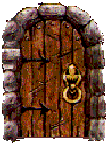Artefacts
The Mary Rose tells a story from the day she sank to the day she
was raised and recovered in 1982. She has also provided archaeologists
with many different and unusual artefacts, including guns and cannons,
personal possessions, and tools belonging to different trades. There were
also many other items of interest.
The study, reproduction and use of these help archaeologists in their
attempts to reconstruct the lives of the people who used them in everyday
life. The ship has also provided thousands of items to help us understand
everyday life on board a Tudor ship of war and given an insight into how
the crew carried out their lives and duties on board the ship.
 Personal
possessions. Most of the artefacts recovered by archaeologists were
left behind in the past accidentally and have only been found by chance.
Its is often hard to tell how old artefacts are, but modern technology
can sometimes be used to date them. The Mary Rose is special because she
gives us information about a known time. The date of her sinking was recorded
as 19 July, 1545, more than 450 years ago. Personal
possessions. Most of the artefacts recovered by archaeologists were
left behind in the past accidentally and have only been found by chance.
Its is often hard to tell how old artefacts are, but modern technology
can sometimes be used to date them. The Mary Rose is special because she
gives us information about a known time. The date of her sinking was recorded
as 19 July, 1545, more than 450 years ago.
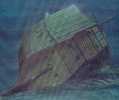 The
Mary Rose on the bed of the Solent after she sank. As the ship sank,
she settled on her side on the seabed. As the years past, the upper side
of the ship was washed away and lost forever by stormy seas. Mud gradually
covered the rest of the ship and helped to preserve the wood for hundreds
of years. The wreck has provided archaeologists all over the world with
evidence of naval history in Tudor times. The
Mary Rose on the bed of the Solent after she sank. As the ship sank,
she settled on her side on the seabed. As the years past, the upper side
of the ship was washed away and lost forever by stormy seas. Mud gradually
covered the rest of the ship and helped to preserve the wood for hundreds
of years. The wreck has provided archaeologists all over the world with
evidence of naval history in Tudor times.
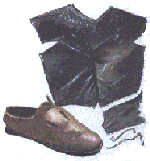 Leather
jerkin and shoe. Only a small amount of clothing has survived from
the Tudor period and what has survived is not generally what was worn by
everyday people who worked. As a result of the conditions underwater for
400 years, remains of the clothing found on the Mary Rose has provided
a whole range of garments worn by sailors, soldiers and officers on board
a ship. The most common type of shoe found on the ship is a slip-on style,
although some of the shoes that were found had buckles and straps or laces
to fasten them. It is likely that bare feet were common among the crew
members. From evidence of clothing found on the Mary Rose, archaeologists
cannot create a complete picture of the clothing worn at the time, but
can make comparisons and guesses when they study paintings and documents
from Tudor times. Leather
jerkin and shoe. Only a small amount of clothing has survived from
the Tudor period and what has survived is not generally what was worn by
everyday people who worked. As a result of the conditions underwater for
400 years, remains of the clothing found on the Mary Rose has provided
a whole range of garments worn by sailors, soldiers and officers on board
a ship. The most common type of shoe found on the ship is a slip-on style,
although some of the shoes that were found had buckles and straps or laces
to fasten them. It is likely that bare feet were common among the crew
members. From evidence of clothing found on the Mary Rose, archaeologists
cannot create a complete picture of the clothing worn at the time, but
can make comparisons and guesses when they study paintings and documents
from Tudor times.
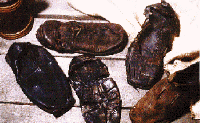 Leather
shoes from the Mary Rose. Woollen and knitted items have not survived
in complete garments and exist in small pieces. However, one nearly complete
woollen jerkin and three woollen hats have been found and conserved. A
few fancy buttons and buckles were recovered from the ship. The buckles
were made from either iron or brass. The metal buckles are of different
sizes and were probably used for belts, shoes and armour. Leather
shoes from the Mary Rose. Woollen and knitted items have not survived
in complete garments and exist in small pieces. However, one nearly complete
woollen jerkin and three woollen hats have been found and conserved. A
few fancy buttons and buckles were recovered from the ship. The buckles
were made from either iron or brass. The metal buckles are of different
sizes and were probably used for belts, shoes and armour.
 Ship's
Bell. The ships bell was one of the last objects to be raised from
the ship before she was lifted in 1982. It was cast from bronze and has
an inscription in Dutch, which, when translated into English reads "I have
been cast in the year 1510". The bell can be seen in the Mary Rose Museum
in Portsmouth Dockyard. Ship's
Bell. The ships bell was one of the last objects to be raised from
the ship before she was lifted in 1982. It was cast from bronze and has
an inscription in Dutch, which, when translated into English reads "I have
been cast in the year 1510". The bell can be seen in the Mary Rose Museum
in Portsmouth Dockyard.
See Also: Raising the Mary Rose
How a sixteenth-century warship was recovered from the seabed
Mary Rose - From Wikipedia
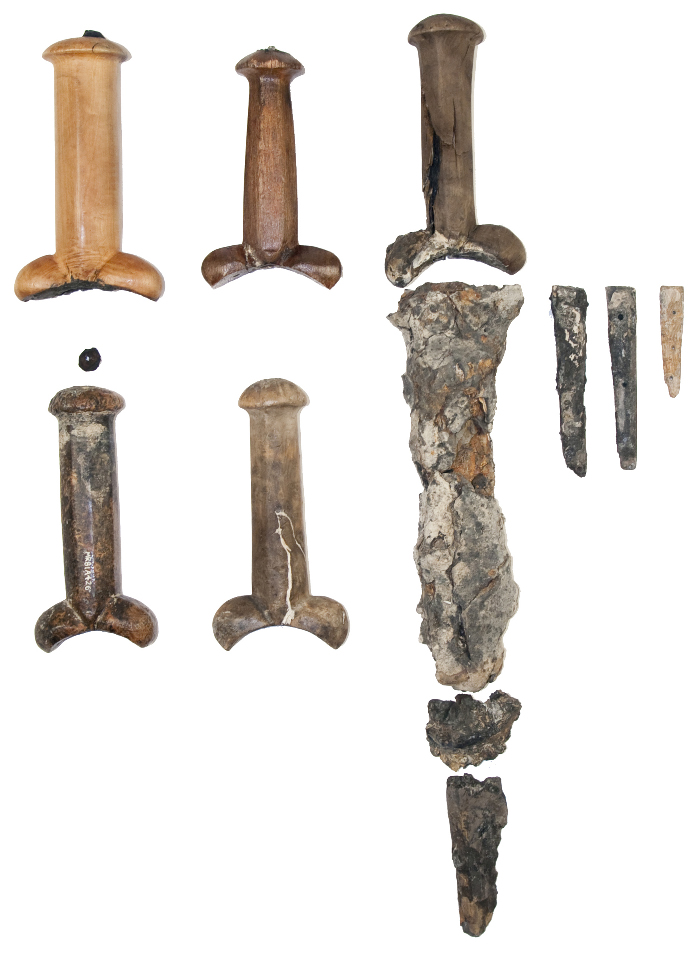 A set of bollock daggers found on board the 16th century carrack Mary Rose, salvaged in 1982.
A set of bollock daggers found on board the 16th century carrack Mary Rose, salvaged in 1982.
Some of the bollock daggers found on board the Mary Rose; for most of the daggers, only the handles have remained
while the blades have either rusted away or have been preserved only as concretions. Credit: The Mary Rose Trust
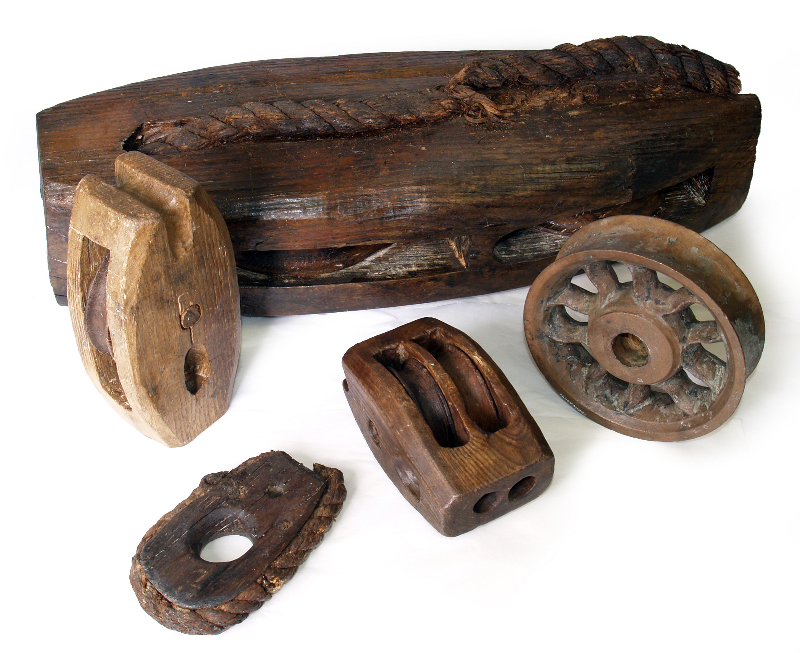 Rigging blocks found on board the carrack Mary Rose.
Rigging blocks found on board the carrack Mary Rose.
A small selection of the many rigging blocks raised from the Mary Rose
Credit: The Mary Rose Trust
|
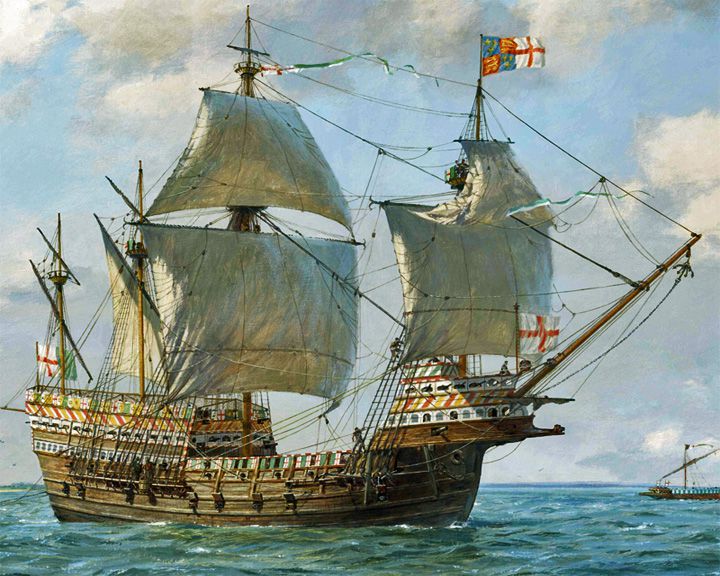
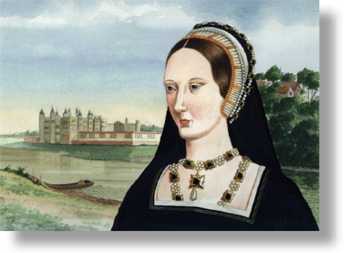
 The
Mary Rose by Roger Purkis. Once the ships were completed, they were
sailed around the south coast of England and up the River Thames to the
Tower of London where they collected their guns and cannons. The Mary Rose
was built as a warship to help defend England from France and Scotland.
For 34 years she served in the defence of England protecting against invasions
from French and Scottish fleets.
The
Mary Rose by Roger Purkis. Once the ships were completed, they were
sailed around the south coast of England and up the River Thames to the
Tower of London where they collected their guns and cannons. The Mary Rose
was built as a warship to help defend England from France and Scotland.
For 34 years she served in the defence of England protecting against invasions
from French and Scottish fleets.
 Bronze
gun on a wooden carriage. Gunpowder was sent onboard the ship in barrels.
It was important that it the gun powder was kept dry otherwise it would
not have exploded when the gun or cannon was fired. It was dangerous to
have gunpowder on board the ship because it would have exploded if a fire
started. This would have destroyed the ship. The Mary Rose was armed with
7 heavy guns on each side of the main deck. When the guns were needed,
the waterproof gun ports were opened and secured. The guns were rolled
forward so that they pointed out of the ship ready to fire.
Bronze
gun on a wooden carriage. Gunpowder was sent onboard the ship in barrels.
It was important that it the gun powder was kept dry otherwise it would
not have exploded when the gun or cannon was fired. It was dangerous to
have gunpowder on board the ship because it would have exploded if a fire
started. This would have destroyed the ship. The Mary Rose was armed with
7 heavy guns on each side of the main deck. When the guns were needed,
the waterproof gun ports were opened and secured. The guns were rolled
forward so that they pointed out of the ship ready to fire. 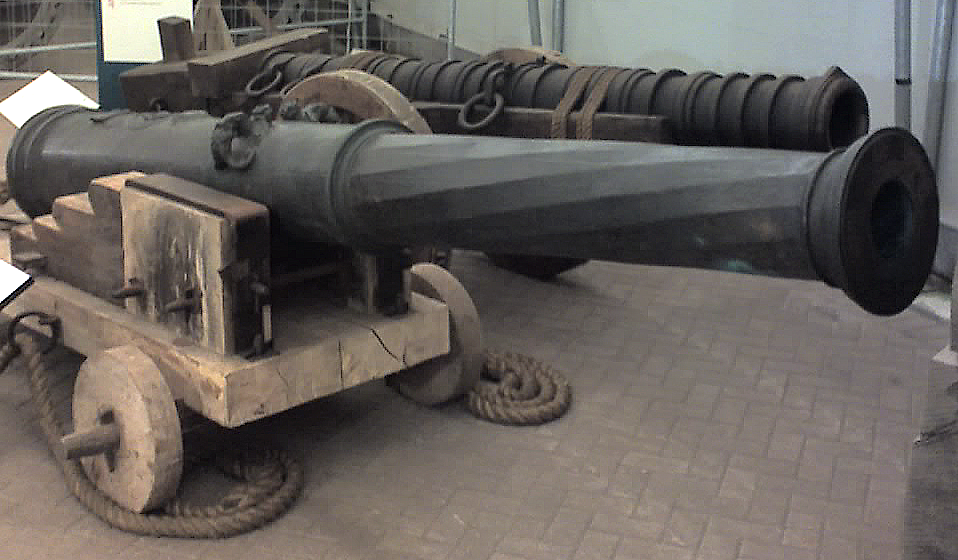
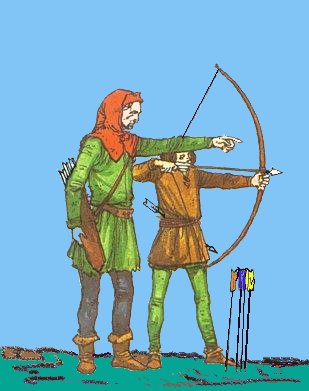 Archery
was a competitive hobby as well as a much needed skill in the Tudor navy.
A boy would be given his first longbow at the time of his seventh birthday.
He would be required to practice every day until he was skilled at firing
an arrow. A document written in 1546, a year after the ship sank records
the number of longbows and arrows that should have been found on board
the Mary Rose. Of the 250 longbows that were on board when the Mary Rose
sank archaeologists found 137 as well as 3500 arrows.Wrist guards were
also discovered on the ship. These belonged to the ship's archers. They
were made from leather and were fastened with straps to the archer's wrists.
Their purpose was to protect the archer from the bowstring as the arrow
was fired.
Archery
was a competitive hobby as well as a much needed skill in the Tudor navy.
A boy would be given his first longbow at the time of his seventh birthday.
He would be required to practice every day until he was skilled at firing
an arrow. A document written in 1546, a year after the ship sank records
the number of longbows and arrows that should have been found on board
the Mary Rose. Of the 250 longbows that were on board when the Mary Rose
sank archaeologists found 137 as well as 3500 arrows.Wrist guards were
also discovered on the ship. These belonged to the ship's archers. They
were made from leather and were fastened with straps to the archer's wrists.
Their purpose was to protect the archer from the bowstring as the arrow
was fired. Personal
possessions. Most of the artefacts recovered by archaeologists were
left behind in the past accidentally and have only been found by chance.
Its is often hard to tell how old artefacts are, but modern technology
can sometimes be used to date them. The Mary Rose is special because she
gives us information about a known time. The date of her sinking was recorded
as 19 July, 1545, more than 450 years ago.
Personal
possessions. Most of the artefacts recovered by archaeologists were
left behind in the past accidentally and have only been found by chance.
Its is often hard to tell how old artefacts are, but modern technology
can sometimes be used to date them. The Mary Rose is special because she
gives us information about a known time. The date of her sinking was recorded
as 19 July, 1545, more than 450 years ago.
 The
Mary Rose on the bed of the Solent after she sank. As the ship sank,
she settled on her side on the seabed. As the years past, the upper side
of the ship was washed away and lost forever by stormy seas. Mud gradually
covered the rest of the ship and helped to preserve the wood for hundreds
of years. The wreck has provided archaeologists all over the world with
evidence of naval history in Tudor times.
The
Mary Rose on the bed of the Solent after she sank. As the ship sank,
she settled on her side on the seabed. As the years past, the upper side
of the ship was washed away and lost forever by stormy seas. Mud gradually
covered the rest of the ship and helped to preserve the wood for hundreds
of years. The wreck has provided archaeologists all over the world with
evidence of naval history in Tudor times. Leather
jerkin and shoe. Only a small amount of clothing has survived from
the Tudor period and what has survived is not generally what was worn by
everyday people who worked. As a result of the conditions underwater for
400 years, remains of the clothing found on the Mary Rose has provided
a whole range of garments worn by sailors, soldiers and officers on board
a ship. The most common type of shoe found on the ship is a slip-on style,
although some of the shoes that were found had buckles and straps or laces
to fasten them. It is likely that bare feet were common among the crew
members. From evidence of clothing found on the Mary Rose, archaeologists
cannot create a complete picture of the clothing worn at the time, but
can make comparisons and guesses when they study paintings and documents
from Tudor times.
Leather
jerkin and shoe. Only a small amount of clothing has survived from
the Tudor period and what has survived is not generally what was worn by
everyday people who worked. As a result of the conditions underwater for
400 years, remains of the clothing found on the Mary Rose has provided
a whole range of garments worn by sailors, soldiers and officers on board
a ship. The most common type of shoe found on the ship is a slip-on style,
although some of the shoes that were found had buckles and straps or laces
to fasten them. It is likely that bare feet were common among the crew
members. From evidence of clothing found on the Mary Rose, archaeologists
cannot create a complete picture of the clothing worn at the time, but
can make comparisons and guesses when they study paintings and documents
from Tudor times.
 Leather
shoes from the Mary Rose. Woollen and knitted items have not survived
in complete garments and exist in small pieces. However, one nearly complete
woollen jerkin and three woollen hats have been found and conserved. A
few fancy buttons and buckles were recovered from the ship. The buckles
were made from either iron or brass. The metal buckles are of different
sizes and were probably used for belts, shoes and armour.
Leather
shoes from the Mary Rose. Woollen and knitted items have not survived
in complete garments and exist in small pieces. However, one nearly complete
woollen jerkin and three woollen hats have been found and conserved. A
few fancy buttons and buckles were recovered from the ship. The buckles
were made from either iron or brass. The metal buckles are of different
sizes and were probably used for belts, shoes and armour.  Ship's
Bell. The ships bell was one of the last objects to be raised from
the ship before she was lifted in 1982. It was cast from bronze and has
an inscription in Dutch, which, when translated into English reads "I have
been cast in the year 1510". The bell can be seen in the Mary Rose Museum
in Portsmouth Dockyard.
Ship's
Bell. The ships bell was one of the last objects to be raised from
the ship before she was lifted in 1982. It was cast from bronze and has
an inscription in Dutch, which, when translated into English reads "I have
been cast in the year 1510". The bell can be seen in the Mary Rose Museum
in Portsmouth Dockyard. 
 Many
different types of tools would have been needed to maintain a ship as big
as the Mary Rose. Three cabins were situated on the main deck, one of them
belonging to the carpenter. Tools were found all over the ship, but most
of them were found inside or near the carpenter's cabin which is situated
on the main deck. The tools found included axes, hammers, mallets, planes
and rulers. Most of the tools have marks scratched into them and these
marks may be an indication of who owned the tools. The most common mark
is W. The ship's carpenter would have been responsible for all repairs,
but while he was not working on repairs, it is likely that he played a
board game called backgammon. A wooden board with markings similar to the
modern game was found along with counters also made from wood in the carpenter's
cabin.
Many
different types of tools would have been needed to maintain a ship as big
as the Mary Rose. Three cabins were situated on the main deck, one of them
belonging to the carpenter. Tools were found all over the ship, but most
of them were found inside or near the carpenter's cabin which is situated
on the main deck. The tools found included axes, hammers, mallets, planes
and rulers. Most of the tools have marks scratched into them and these
marks may be an indication of who owned the tools. The most common mark
is W. The ship's carpenter would have been responsible for all repairs,
but while he was not working on repairs, it is likely that he played a
board game called backgammon. A wooden board with markings similar to the
modern game was found along with counters also made from wood in the carpenter's
cabin. 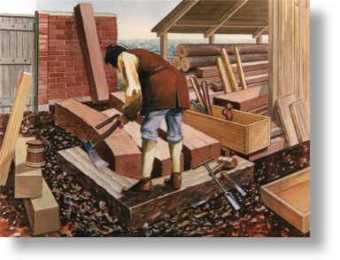
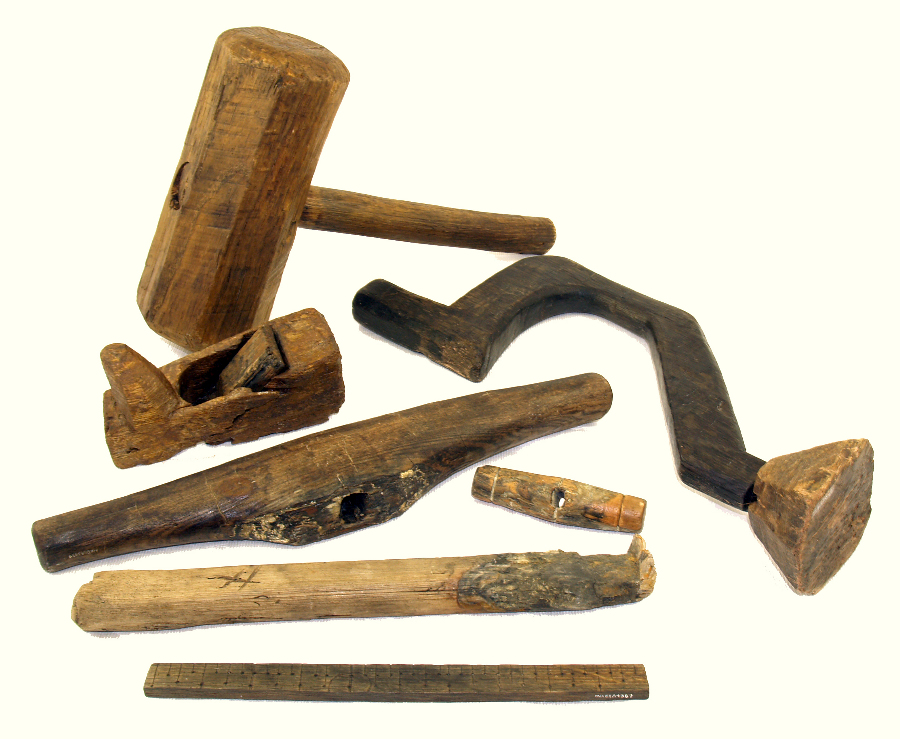
 Peppercorns
from the Mary Rose. Information about food on board the Mary Rose was
gained by a study of remains and bones recovered during the excavation.
Several hundred plum stones found in a wicker basket show that fresh fruit
was taken on board and stored. Other food was available to the crew including
pork, beef, mutton and fish. The meat was stored on the ship in barrels,
whereas the fish was stored in baskets at the stern of the ship. Fish would
have been cod and were probably dried and salted to help stop them from
going mouldy.
Peppercorns
from the Mary Rose. Information about food on board the Mary Rose was
gained by a study of remains and bones recovered during the excavation.
Several hundred plum stones found in a wicker basket show that fresh fruit
was taken on board and stored. Other food was available to the crew including
pork, beef, mutton and fish. The meat was stored on the ship in barrels,
whereas the fish was stored in baskets at the stern of the ship. Fish would
have been cod and were probably dried and salted to help stop them from
going mouldy.
 Items
used for eating and drinking. Facilities on board the ship were simple
because there was not much space in the kitchen. There were two ovens,
which were made up of over 4,000 bricks. The ovens would have held two
cauldrons, which were used to cook the food for the crew. Dinner would
have been a stew made from the meat or fish that was carried on board.
The officers would have eaten the stew from pewter plates and bowls, crewmembers
from wooden bowls. Dried bread, or ships' biscuits, would have accompanied
the stew meals.
Items
used for eating and drinking. Facilities on board the ship were simple
because there was not much space in the kitchen. There were two ovens,
which were made up of over 4,000 bricks. The ovens would have held two
cauldrons, which were used to cook the food for the crew. Dinner would
have been a stew made from the meat or fish that was carried on board.
The officers would have eaten the stew from pewter plates and bowls, crewmembers
from wooden bowls. Dried bread, or ships' biscuits, would have accompanied
the stew meals. 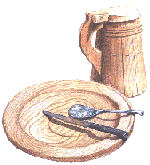 Drinks were served in wooded tankards, although seven pewter
tankards, probably belonging to the officers were discovered around the
ship. Forks were not used to eat with on the Mary Rose. No forks
were found and only a few spoons were recovered. Fifty-eight knives were
found and were used for general purposes as well as eating.
Wooden plate
and tankard.
Drinks were served in wooded tankards, although seven pewter
tankards, probably belonging to the officers were discovered around the
ship. Forks were not used to eat with on the Mary Rose. No forks
were found and only a few spoons were recovered. Fifty-eight knives were
found and were used for general purposes as well as eating.
Wooden plate
and tankard.
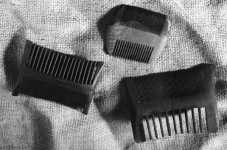 Fine
toothed combs. The cramped conditions in the living areas of
the ship, along with long hair and beards encouraged the spread of head
lice and fleas. More than 75 fine toothed combs were recovered from the
shipwreck. They would have been used by crew members as they tried to get
rid of the insects. The living conditions for the crew members on board
the Mary Rose were very poor. There were no washing facilities such as
baths and showers and there were no toilets. The crew members would have
perched on a plank over the water to go to the toilet. A single pewter
chamber potty that was found probably belonged to an officer on board the
ship.
Fine
toothed combs. The cramped conditions in the living areas of
the ship, along with long hair and beards encouraged the spread of head
lice and fleas. More than 75 fine toothed combs were recovered from the
shipwreck. They would have been used by crew members as they tried to get
rid of the insects. The living conditions for the crew members on board
the Mary Rose were very poor. There were no washing facilities such as
baths and showers and there were no toilets. The crew members would have
perched on a plank over the water to go to the toilet. A single pewter
chamber potty that was found probably belonged to an officer on board the
ship. The
important facts that need to be collected for the accurate navigation of
a ship are the direction, time, distance and the depth of the water under
the ship. Modern warships use computers and satellites to help with their
navigation around the world. In Tudor times, the navigator would have to
be able to recognize coastlines using his eyes only. Recognizing land features
such as harbours, beaches, buildings and castles would inform him of the
ships whereabouts. The Mary Rose was equipped with the latest Tudor navigation
equipment, a magnetic compass to indicate which direction she was sailing.
A sounding line, which is a piece of string with a lead weight at the end
of it, was used to gauge the depth of the water. The lead weight would
have been thrown overboard into the sea and then the depth calculated by
marks already made on the string and a log reel.
The
important facts that need to be collected for the accurate navigation of
a ship are the direction, time, distance and the depth of the water under
the ship. Modern warships use computers and satellites to help with their
navigation around the world. In Tudor times, the navigator would have to
be able to recognize coastlines using his eyes only. Recognizing land features
such as harbours, beaches, buildings and castles would inform him of the
ships whereabouts. The Mary Rose was equipped with the latest Tudor navigation
equipment, a magnetic compass to indicate which direction she was sailing.
A sounding line, which is a piece of string with a lead weight at the end
of it, was used to gauge the depth of the water. The lead weight would
have been thrown overboard into the sea and then the depth calculated by
marks already made on the string and a log reel.
 Navigation
equipment and pocket sundial. Another piece of equipment used for navigation
was a device called the log-reel. This was a piece of string with knots
tied at even distances along it. The knotted string was wrapped around
a large wooden reel with the loose end tied to a piece of wood called the
"chip". When the navigator wanted to know the speed of the ship, he would
throw the chip overboard into the water and the knotted line would reel
out after it. The number of knots would be counted and timed by a sandglass.
The number of knots that went into the water after the chip in a given
time would show the speed of the ship in knots. Navigation equipment
used on board and recovered by archaeologists from the wreck are three
compasses, two pairs of dividers, a log reel, parts of at least four sandglasses
and a pine board, which may have been used for recording or planning a
route.
Navigation
equipment and pocket sundial. Another piece of equipment used for navigation
was a device called the log-reel. This was a piece of string with knots
tied at even distances along it. The knotted string was wrapped around
a large wooden reel with the loose end tied to a piece of wood called the
"chip". When the navigator wanted to know the speed of the ship, he would
throw the chip overboard into the water and the knotted line would reel
out after it. The number of knots would be counted and timed by a sandglass.
The number of knots that went into the water after the chip in a given
time would show the speed of the ship in knots. Navigation equipment
used on board and recovered by archaeologists from the wreck are three
compasses, two pairs of dividers, a log reel, parts of at least four sandglasses
and a pine board, which may have been used for recording or planning a
route. 